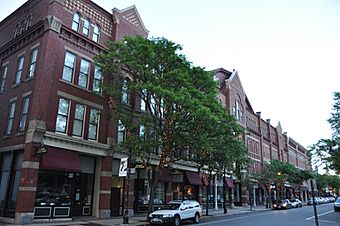Harrington-Smith Block facts for kids
Quick facts for kids |
|
|
Harrington-Smith Block
|
|
 |
|
| Location | 18-52 Hanover St., Manchester, New Hampshire |
|---|---|
| Area | less than one acre |
| Built | 1880 |
| Architect | John T. Fanning |
| Architectural style | Queen Anne |
| NRHP reference No. | 86003367 |
| Added to NRHP | January 28, 1987 |
The Harrington-Smith Block is a very old and important building in Manchester, New Hampshire. It used to be called the Strand Theater and the Manchester Opera House. This historic building is located at 18-25 Hanover Street, right in the center of the city.
It was built in 1881 by an architect named John T. Fanning. Two important local builders asked him to design it. The building shows off a special style called Queen Anne, made with brick and stone. For many years, it was the main place in the city to watch performances. It was also one of the first homes for the Manchester Union Leader, a big newspaper in New Hampshire. The building was added to the National Register of Historic Places in 1987.
What is the Harrington-Smith Block like?
The Harrington-Smith Block is in downtown Manchester. It stretches about 200 feet (61 meters) along Hanover Street. It also goes about 95 feet (29 meters) along Elm Street. Elm Street is the main road in downtown Manchester.
Building Design and Features
The middle part of the building is four stories tall. It is mostly made of red brick. There are eight storefronts on the ground floor. These are separated by brick columns that go all the way up the building. The main entrance, which used to lead to the opera house, sticks out a little. There are also other entrances at each end of the building.
The storefronts have cool metal panels above them. Their entrances are set back a bit, with display windows on each side.
Past and Present Uses of the Building
This building was designed to hold shops and businesses. It also had a large performance hall in the back. That hall is not there anymore. The Manchester Union Leader newspaper started out in this building.
After the 1930s, many of the city's factories closed down. Because of this, the upper floors of the building were changed into apartments. In 1985, there were big fires that destroyed the performance hall. The rest of the building's inside was also badly damaged. But it was fixed up! Today, it still has shops on the ground floor and homes on the upper levels.



